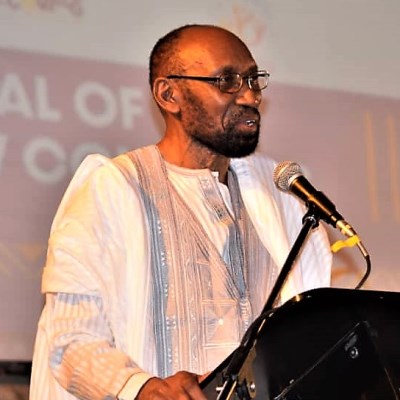
Dir: Amil Shivji
The opening of the film with the turning off of streetlights in old time Zanzibar is a most poignant symbol of the longing for the past of this film from Tanzania. The film about the end of the colonial period marked by the independence struggle of an African people symbolizes a poignant moment in world history and the history of film in Tanzania. Director Amil Shivji’s rise in the African cinema world has been expected, but the film still surprises many with its confident and strongly assertive power and creativity.
The film is based on a Kiswahili novel of the same title by Shafi Adam Shafi discussing the underlying tensions between the ruler and the ruled in a colonial setting, through a love story steeped in the colonial environment, that of the tensions of race and individual freedom.
The film is an important landmark in Tanzania, being a first of its kind, as an internationally distributed film based on a novel. Interesting Tanzanian movies have been made based on novels by Hammie Rajab, Euphraise Kezilahabi and others, but the earlier works have all ended in being of the Bongo movies type that often focus on local distribution.
It is also a landmark in that it is only the second film to be selected for the Oscars under the International Film Category. Tanzania’s only other film to have been selected was Maangamizi (Martin Mhando and Ron Mulvihii, 2001) which was a historical milestone for Africa. Maangamizi was the first film, from Sub-saharan Africa, to be so selected.
As a historical film it covers an important period of the history of Zanzibar and of Tanzania, that of the independence struggle. As a view from the bridge of time Amil Shivji’s analysis of that colonial period is somewhat muted but understandably so given the 60 years of a tumultuous history.
The Story
The film tells the story of Yasmin, a beautiful and young Zanzibari woman of Indian descent, who gets married to a man who could easily be her father. This fateful marriage was bound to fail given Yasmin’s strong character. Having acquiesced to the marriage to appease her parents, she nonetheless has the strength, very early on, to walk out of the marriage and straight into a new world, so different to what the colonial world had designed. The colonial world of Zanzibar, as in many parts of the world, was a stratified world according to race.
In Zanzibar there were clear racial divisions and the colonial world was happy to control the population under the three tiers of Whitedom (represented by Inspector Wright), Asiatics (represented by Raza, Gulam and Yasmin) and Africans (represented by Denge, Mwajuma, and Mambo). It is often said that identity is a complex phenomenon and anthropologist Marcia Langton argues that:
| [Identity]… is a field of intersubjectivity in that it is remade over and over again in a process of dialogue, of imagination, of representation and interpretation. (1993, 33-34). |
To the colonialists identity was easy. The town in which Yasmin lived was a place where during the colonial period those designated to be Africans could not live beyond 6.30pm (sunset). A siren would go to signal that those who were not allowed to be in the city needed to get out until sunrise again. (In a cruel twist of fate the siren still goes but now it signals the end of the government day marked by the drawing down of the state flag). The film gives us an insight into the life of a people, their struggles and their cultures. In the music and in the relations lie living expressions of a people. What Amil does here, to quote Mwajuma is to sing about Zanzibar, ‘Nitawaimbia mpaka Zanzibar nzima isikie’. No major film has been made about Zanzibar, the story of Zanzibar is not about tourism but the pains and pleasure of a people.
This is the world that Yasmin dares confront with her love for an African, when she begins living in the African quarters, Ng’ambo, beyond the perimeters of Stonetown.
The woman’s world
In the novel, the place of the woman is defined. She has no say and can never make any decisions on her own. But this is turned on its head in the film where we see Yasmin fight for her love, fight for her freedom, fight to change not only her fate but the fate of her people.
I make a special note of the difference between the film and the novel because it is obvious that Amil Shivji decided to take a huge leap to tell a very contemporary story of the woman Yasmin, whom not many would recognize in those times. The artistic liberty that Amil takes to create and develop Yasmin marks an important narrative trajectory: a story that needs to be told.
This is a subject about the film that could take a whole essay to unravel but suffice to say that Africa’s need for narratives that reflect a new way of conceptualizing the continent’s history and future is answered by this film. Narratives are often described as a collection or system of related stories that are articulated and refined over time to represent a central idea or belief. The prevailing stereotypical narrative of Africa as the continent of poverty, disease, conflict, poor leadership, corruption and powerless oppressed women, is outdated. (Africa No Filter).
Vuta N’Kuvute refines the narrative around Africa: No stereotypes accommodated; a story of hope and inspiration; a film of agency and urgency.
Danger in the New Narratives
When a people opt to tell new narratives, they also have to be wary of the many traps laid out for them.
The script is well written, a collaborative effort by Amil Shivji and Jenna Bass, with the woman’s perspective given much importance. Vuta N’Kuvute the movie, deliberately strengthens the woman’s story way above the novel’s intent. Indeed, an adaptation is not a time capsule that it has to adhere to the past. However, as we struggle to build strong narratives about Africa, we must be careful about what Chimamanda Adichie calls, the danger of a single story. As most Western film support grants and even investments have ‘default positions’, these can lead to default assumptions and misunderstandings. The ‘well-meaning pity’ that Adichie warns us of is real and we need to be aware of.
Yasmin’s freedom has here been entwined to the independent struggle. To what purpose may we ask? Is it to remind us that women have played important roles in the African independence struggles that we hardly hear about? Many people sometimes struggle with these default positions and assumptions because of the essentialism that come with them. Recontextualised within feminism, essentialism becomes the view that there are properties essential to women, in that any woman must necessarily have those properties to be a woman at all. The femme fatal theme in this film builds in these unnecessary conditions.
I would have loved for Amil and Jenna to focus more on the social constructionist perspective of gender, which was actually inherent to the story, and reduce the alure of the sexual qualities of the woman. The default position of social interaction leading to new positions would have been enough to elevate the two women in the story to role models.
The input of the two women into the struggle, with or without their alluring qualities, is enough to endear us to them. Race distinctions have been openly underplayed in this film showing race as only a colonial distinction. This is an important anti-colonial perspective. It may be generalizing the struggle and simplifying it, but it was necessary to show how race was simply part of the story of the politics of colonial advantage or disadvantage.
The politics of the film are carefully stated; the fight for independence must also be a fight for individual freedom, something that our independence leaders failed to comprehend, leading to the often-dictatorial decisions of past and present leaders. The theme of destiny where Denge’s freedom is secured and Yasmin’s is not, is a strong message of society. When Denge asks, “Yasmin, uko huru?”, (Yasmin, are you free?) one can almost hear Amil’s voice asking himself if, he himself yuko huru? Indeed, the script fuses many civil society messages such as the role of women in the struggle (Yasmin’s hand on the ‘makaratasi’) or that of agency, while the song Kigalawa, reminds us that political structures are simply vehicles, and ocean bound vessels are destined to be struck by storms. Ties between Zanzibar and Tanganyika are conclusively stated, making a statement about their geographical and cultural compatibility, which continue to be hit by political storms, as Amil intimates.
The literary links to the film are a strong theme running through. For example, the spectacle of cats roaming the Stonetown is a common literary motif also highlighted by none other than Abdulrazal Gurnah, the 2022 Nobel laureate. The discussions about the types of bread, the name of the new newspaper Kimbunga (Storm) and even the saying ‘Nchi ni zaidi ya tundu la mwewe, tutajenga yanayoyumkinika’ (a country is more than a hawk’s hole, we will build what is possible) foreground Swahili culture and are literary motifs suffusing the film just as music is presented as the language of struggle. The diversity of music types from rumba to taarab is used to good effect and underlays the film’s historical context.
Finally, a few slipups haunt the film’s directorial strength. At some stage early on, the pace is too slow and we notice it, but cleverly when threatened the film picks up pace and drama rises. The dialogue is well written but, and this is a big but, one notices its English language base. That even the Swahili dialogues must have been translated from English, together with the diction of some of the characters, (Denge’s (Gudrun Mwanyika) being prominent) irks the discerning Swahili speaker. Sometimes we see the director misses important spots of dialogue where a more reflective or symbolic tone would have worked better than simple ‘talk’. Yasmin’s (Iklas Vora) dialogue is well crafted and her diction superb. So too is Mwajuma’s (Siti Amina) flawless performance, but oftentimes we notice the English language base of the translation. The beauty of the Swahili diction, the diversity of words, tones, dialects and accents is killed when dialogue is based on English language.
When it comes to action I wonder when or if Amil will ever become an action director! Indeed maybe, like myself, he should leave that to others. Performances in the film are good with a clear difference in qualities. Amina and Gabo’s (Ahmed Salum) performances stand out while Gudrun’s and Iklas’ performances are sometimes not so smooth, but certainly satisfactory.
The suggestive editing is put to excellent effect just like the many symbolic links between Zanzibar and Tanganyika, in peoples, politics, histories and literature, making it a truly African filmic expression. A longing of the heart from this political storyteller of our times.
Martin Mhando
Zanzibar- 25 October 2022



